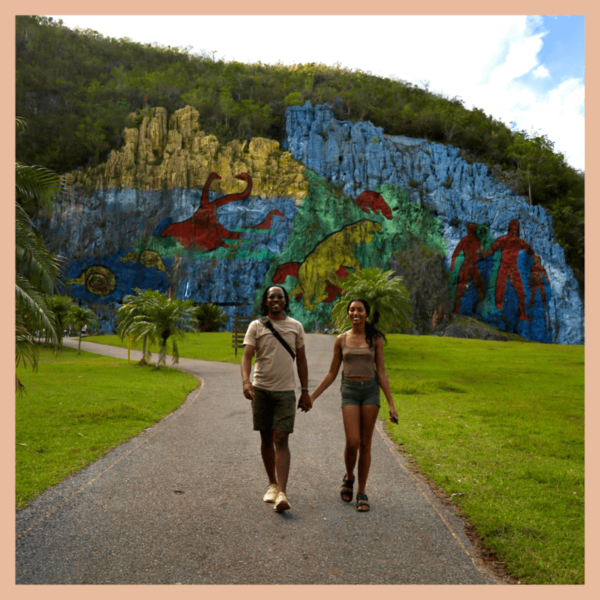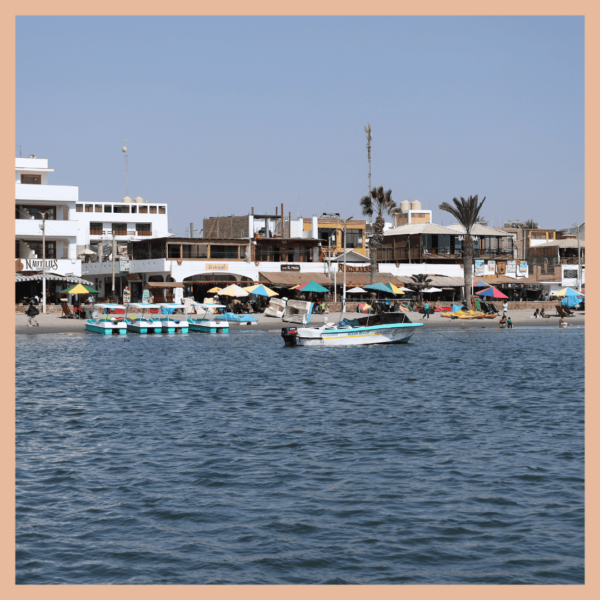
Table Mountain is one of Cape Town’s top sights for a reason. Here’s your go-to guide with everything you need to know, from ticket tips and weather timing to hikes, cable cars, and what it’s really like at the top.
Disclosure: This post may contain affiliate links, which means we’ll receive a commission if you purchase through our links, at no extra cost to you. Please read full disclosure for more information.
As someone who’s traveled to over 50 countries, I’ve seen plenty of “must-see” viewpoints.
A lot of them end up being forgettable or way too crowded.
But Table Mountain? It genuinely stood out.
It wasn’t just the view, but it was the whole experience.
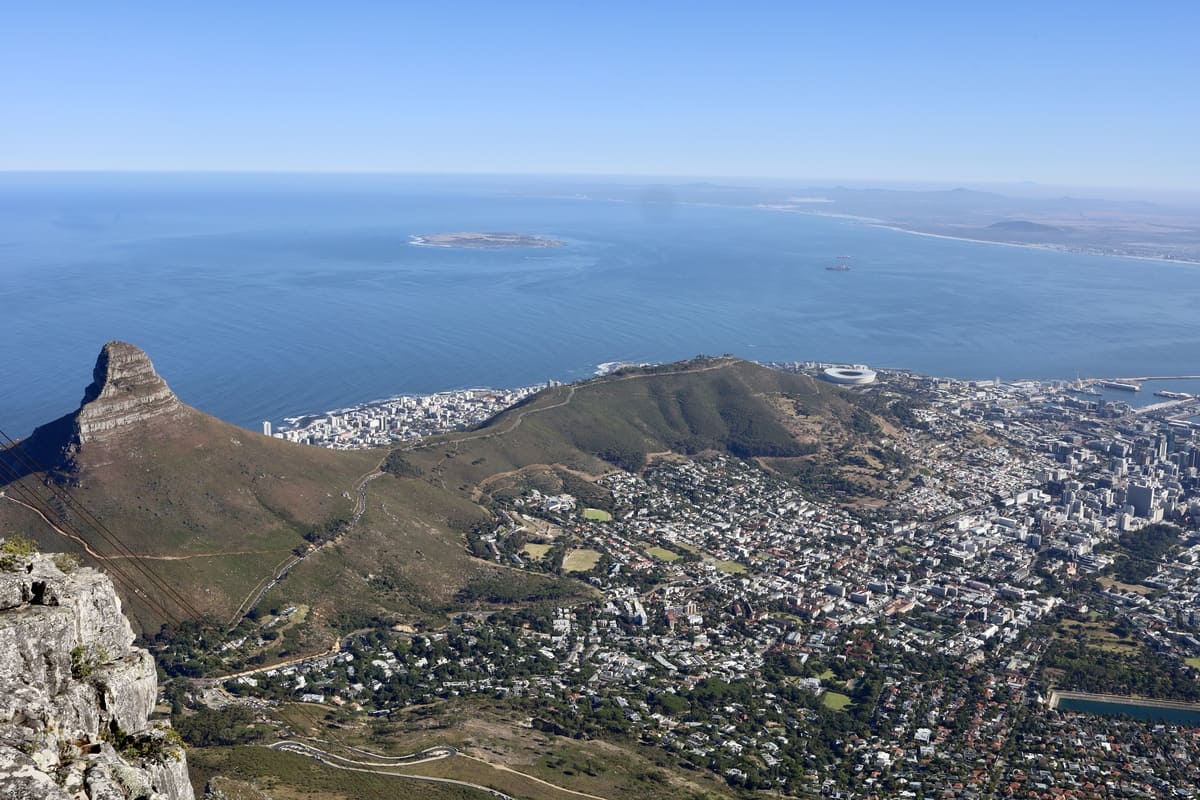
The quiet at the top, the shifting perspective from the rotating cable car, the way the mountain makes the city feel small.
If you’re planning a visit, this guide is packed with practical tips from my own trip—what to expect, how to avoid the lines, how to save a little cash, and how to actually enjoy your time up there without feeling rushed or overwhelmed.
What Makes Table Mountain Worth Visiting?
Before visiting Cape Town, I thought Table Mountain might be one of those places that’s more famous than it is impressive.
But standing at the top changed my mind completely.
It’s not just the view, though the views are incredible.
On a clear day, you can see the city stretch out below you, Robben Island in the distance, and the dramatic coastline wrapping around the peninsula.

But what really makes it special is the combination of nature, history, and perspective.
Table Mountain is one of the New7Wonders of Nature and sits within the UNESCO-listed Cape Floral Region, which holds some of the most unique plant life on the planet.
Thousands of species grow here, many of which exist nowhere else in the world.
It’s also a place with deep roots.
For centuries, it’s been a sacred site for Indigenous communities, a guidepost for sailors, and a part of daily life for people who call Cape Town home.
It’s rare to find a viewpoint that holds this much meaning, and that’s part of what makes it stick with you long after you’ve left.
How to Get to Table Mountain
Table Mountain is just 10 to 15 minutes from Cape Town’s city center, making it one of the most accessible adventures in the area.
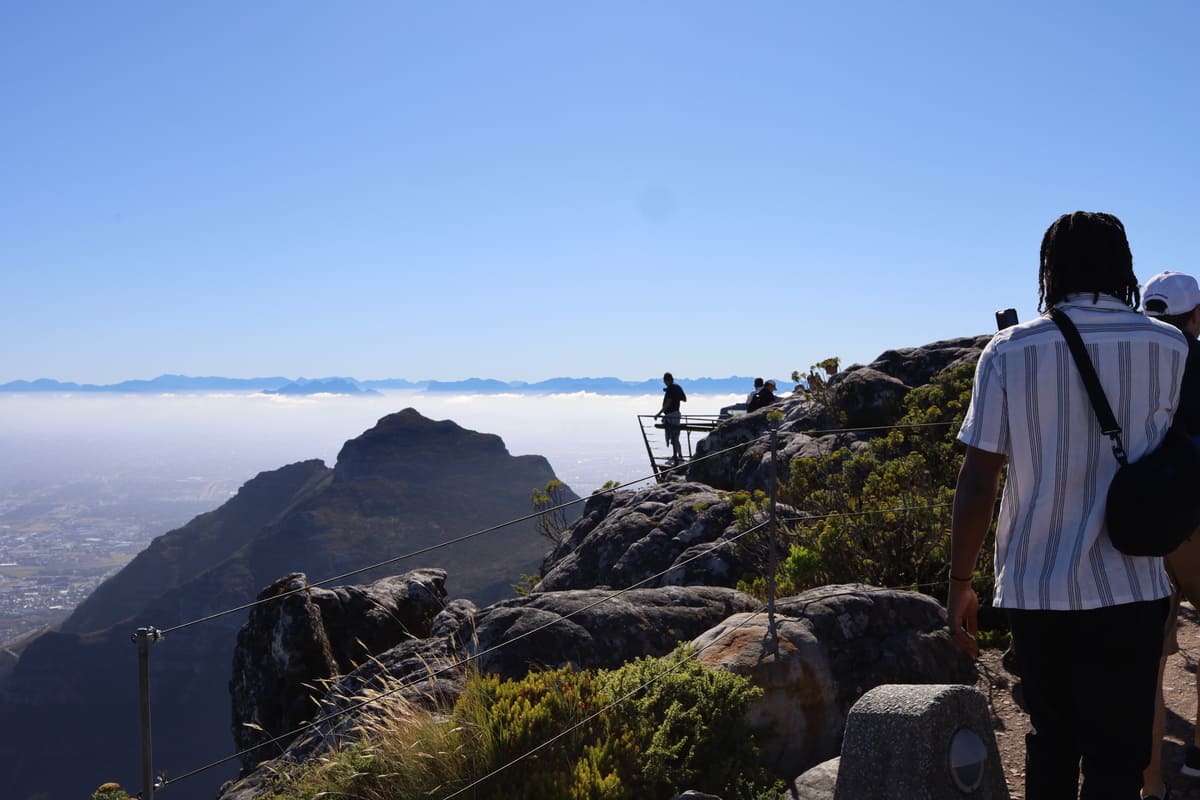
Here are the best ways to get there:
Uber or Bolt: The easiest option, especially if you’re not renting a car. Rides from central Cape Town usually cost between $4 and $8 USD depending on the time of day and traffic.
Hop-On, Hop-Off Bus: The red City Sightseeing buses include a stop at the Lower Cableway Station. This is a great option if you’re already using the bus to explore Cape Town.
Public Transport: There isn’t a direct or convenient public bus to the cableway station, and local minibuses are not recommended for tourists due to safety concerns and unpredictability. Stick to Uber or the sightseeing bus for peace of mind.
Free Shuttle (If Driving): If you’re driving, there’s a free park-and-ride shuttle that runs every 10–15 minutes from the lower Tafelberg Road parking lot up to the cableway station. You’ll see signs pointing you to the shuttle area once you’re near the base.
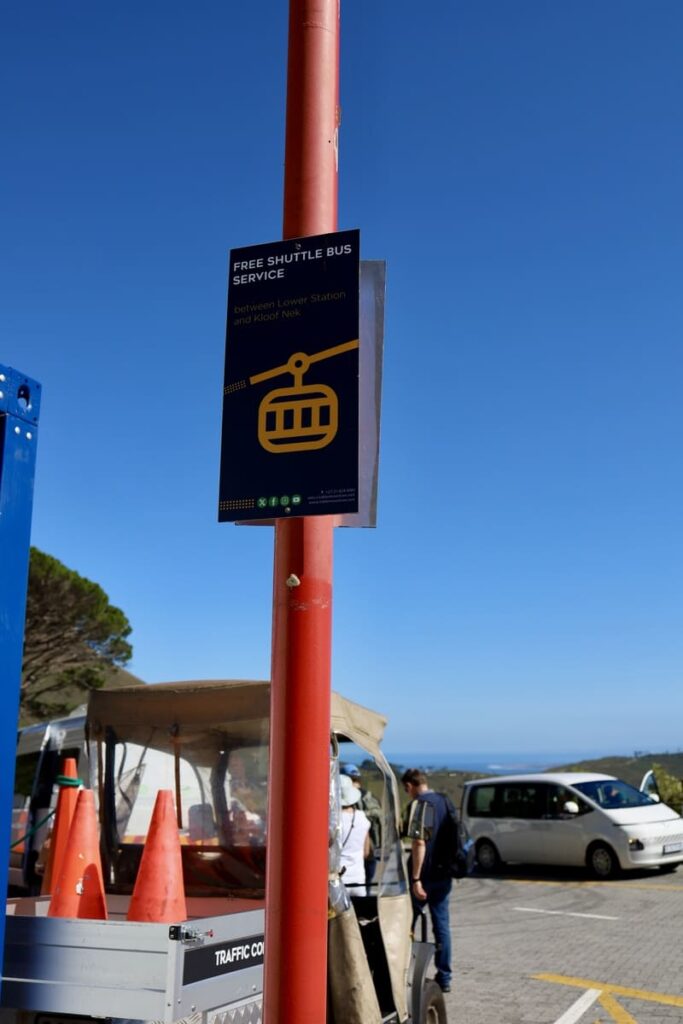
Parking Tips
Parking is extremely limited. We arrived by 8:15 AM and nearly missed a spot.
If you’re driving yourself, aim to arrive no later than 7:45 AM, especially during weekends, holidays, or peak travel months (December – February).
And if you’re not a morning person, consider grabbing a ride instead of dealing with parking at all.
Best Time to Visit Table Mountain
If there’s one thing to know about Table Mountain, it’s that the weather has the final say.
The views are stunning when the skies are clear, but fog, wind, or cloud cover (known locally as the “tablecloth”) can roll in fast and shut everything down, even on a day that started sunny.
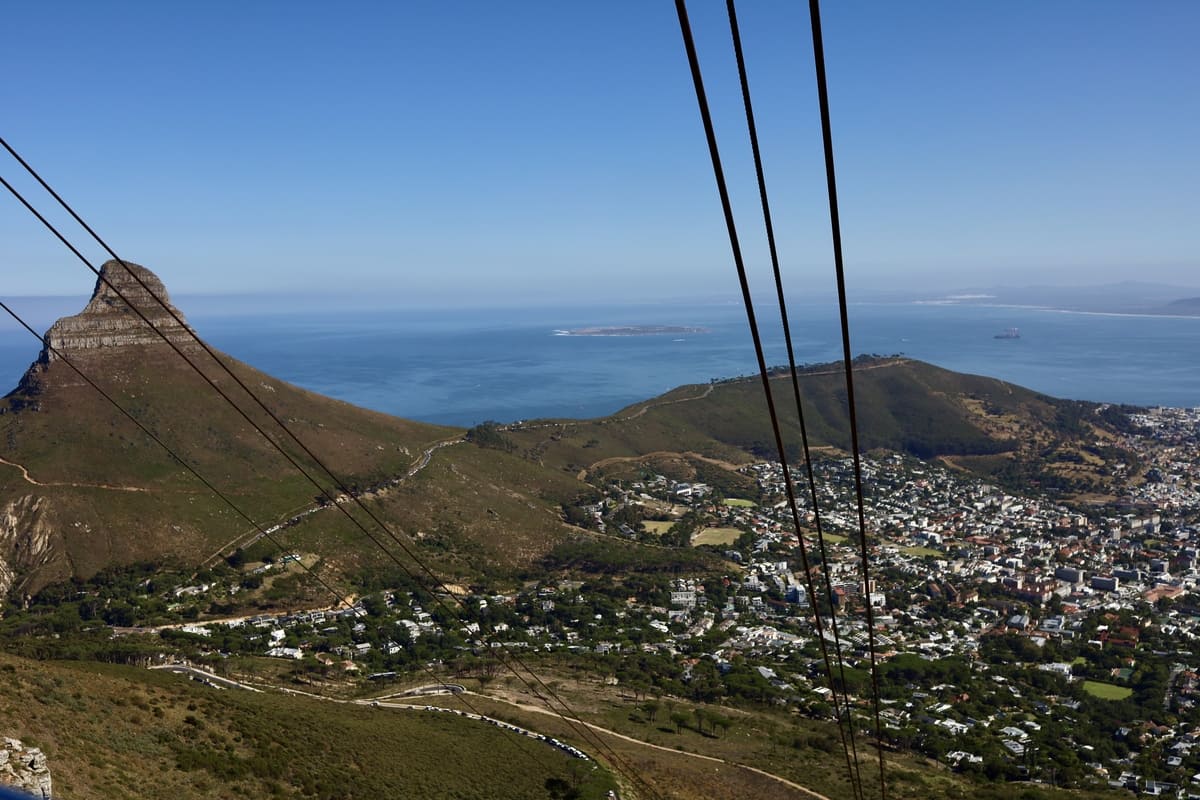
Here’s how to time your visit right:
Season by Season
- Summer (December to March): This is peak season for a reason featuring clear skies, long daylight hours, and warm temps. It’s great for photos, but also the busiest time. Expect longer lines, especially midday.
- Winter (June to September): Fewer crowds, but you’re playing weather roulette. Rain and thick cloud cover are common. You might get lucky with clear skies after a storm, but cableway closures happen more often this time of year.
- Spring and Autumn (October to December, March to May): These are the sweet spots. Mild weather, smaller crowds, and a better chance of clear skies without the summer chaos.
What Time of Day is Best?
- Early Morning: Your best bet for clear views and short lines. We got there around 8:30 AM and had no wait.
- Afternoon/Sunset: Gorgeous if the weather holds, but this is also when the cableway is busiest. If you’re hoping to catch golden hour, make sure the cableway is still open and running.
The cable car has different hours depending on the season.
Generally, the first ride up starts around 8:00 AM and the last one down is around sunset, but these hours can change.
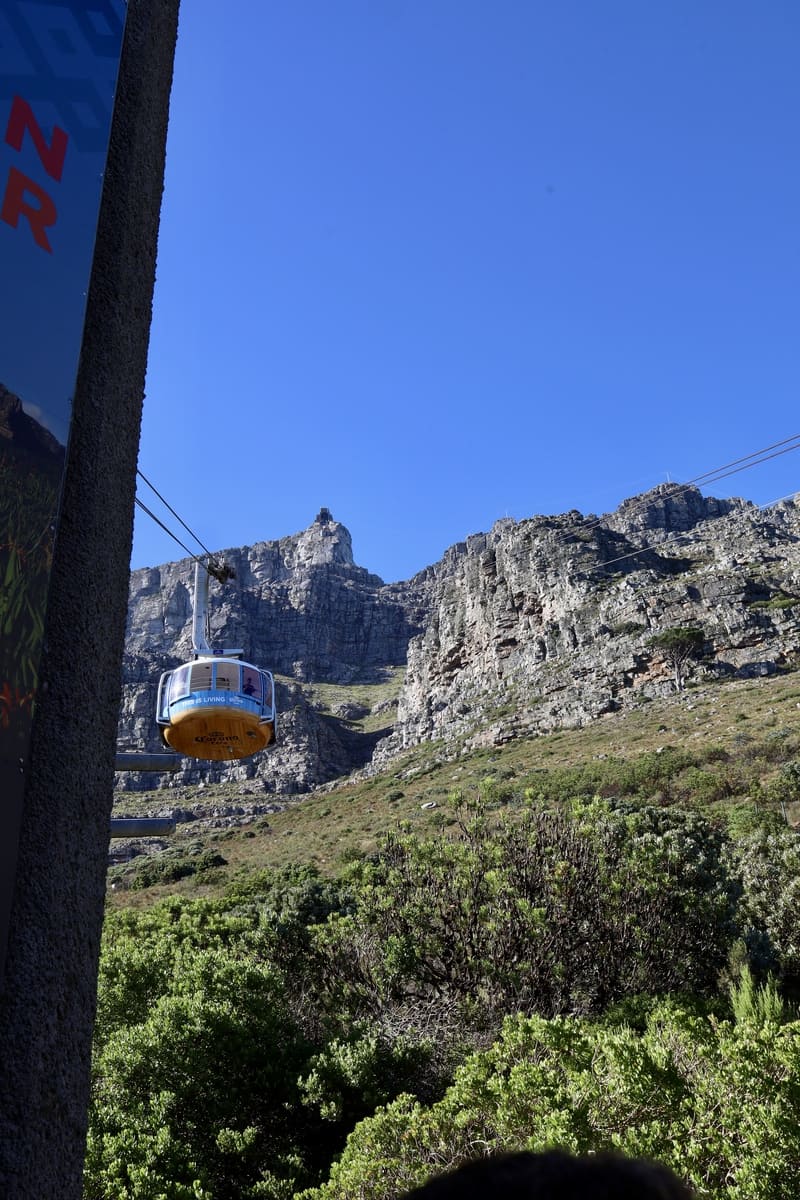
Always check the official Table Mountain Aerial Cableway site for the most up-to-date info, especially if you’re planning a sunset visit.
Chew Tip: Visit early in your trip if you can. That way, if the mountain is closed due to weather or wind, you’ve got a backup window to try again.
Getting to the Top of Table Mountain
There are two ways to reach the summit: ride the cable car or hike.
Either way, the views at the top are some of the best you’ll find anywhere in the world.
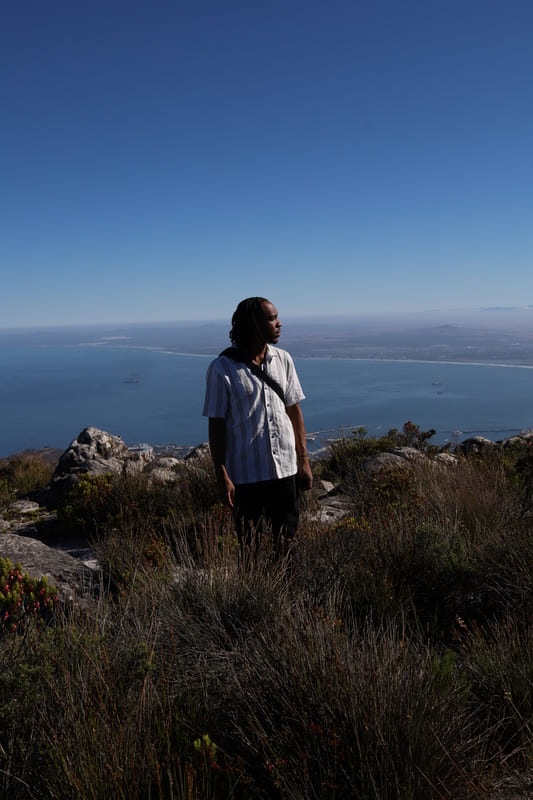
Cable Car Details
If you’re not up for a strenuous hike (or just want to save time), the Table Mountain Aerial Cableway is the easiest way up.
- Start Time: The first cable car typically runs around 8:00 AM, but hours vary by season. Always check the official website before you go.
- Duration: The ride is quick, only about 3 to 5 minutes, and the floor rotates, so everyone gets a 360-degree view on the way up.
- Tickets: Adult tickets cost around ZAR 490 (about $25 USD) on-site or ZAR 430 ($22 USD) if you book online. Afternoon-only tickets are cheaper.
- Accessibility: The cableway is wheelchair-friendly. You can read more on local accessibility info here.
- Weather Advisory: The cable car stops running in high winds or poor visibility. Check the live status before heading out, especially in winter.

Tips:
- Book online to save money and skip the long ticket line.
- Tickets are valid for 7 days from the date you select, which gives you some wiggle room if the weather isn’t ideal.
- Try to arrive early in the day to avoid crowds.
Once you’re at the top, you’ll find a network of short walking trails and viewing decks with incredible angles of the city, coastline, and distant mountains.

On a clear day, you can even see Robben Island.
Free walking tours leave from the upper cable station at 10:00 AM and 12:00 PM daily and are worth joining if you’re interested in learning more about the mountain’s history and biodiversity.
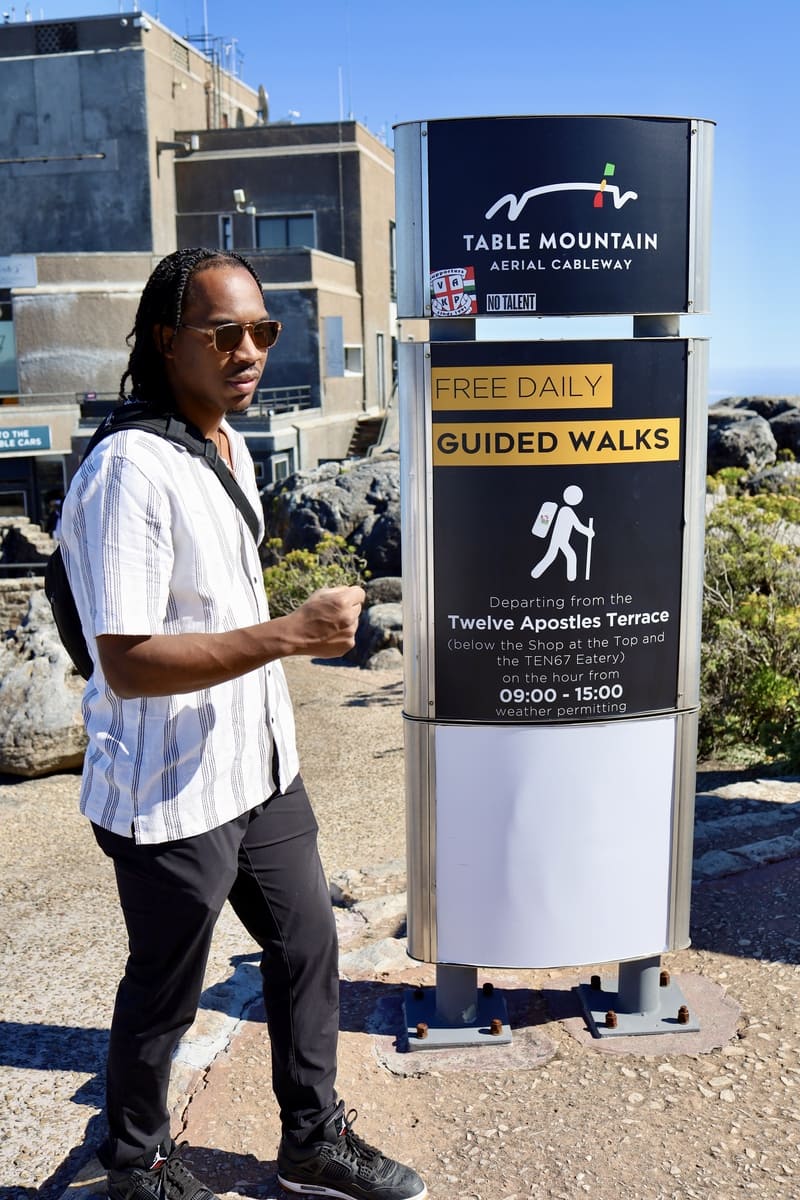
Hiking Table Mountain
If you’re up for a challenge, hiking to the summit is a memorable experience, but it’s no casual stroll.
These are the most popular routes:
- Platteklip Gorge: The most direct trail to the top. It’s steep and rocky, but doable for most people with a reasonable fitness level. Expect anywhere from 1 hour to 2 hours one way, depending on pace and breaks.
- India Venster: A more advanced route with some scrambling involved, but comes with more scenic views along the way. Definitely not beginner-friendly, and coming down is even harder. It takes about 2 to 4 hours to go up this trail, and it’s recommended to take the cable car on your way back down.
- Skeleton Gorge: Starts in Kirstenbosch Botanical Gardens and winds through a lush, shaded forest. It’s a longer, moderate hike (more like 4.5 hours one way), but the scenery at the top is worth it.
Hiking Tips
- Wear proper shoes. Some trails have loose rocks and steep drop-offs.
- Bring plenty of water, sunscreen, and snacks.
- Hike in a group if possible, especially if you’re unfamiliar with the trail.
- If you’re planning to take the cable car down, double-check it’s running before your hike. If it’s shut due to wind, you’ll need to hike back down.
For those feeling extra adventurous, there’s even an option to abseil (rappel) off the top of the mountain.
Personally, I’m not doing all that, so I’ll leave all the fun for the true thrill seekers.

What to Expect at the Summit
Reaching the top of Table Mountain is the kind of moment you’ll want to slow down for.
It’s not just a quick photo op. This is more of a whole experience.
Once you step off the cable car or finish your hike, you’ll find a network of trails that lead to different lookout points across the mountain’s flat summit.

Each one offers a slightly different view—some overlooking Cape Town’s city bowl, others stretching out toward the Atlantic Ocean or across to Robben Island.
The air is crisp, and the wind can kick up quickly, so having a layer in your bag is a good call.
There’s also a small café where you can grab a warm drink or a snack, plus restrooms and a souvenir shop if you want to pick something up.
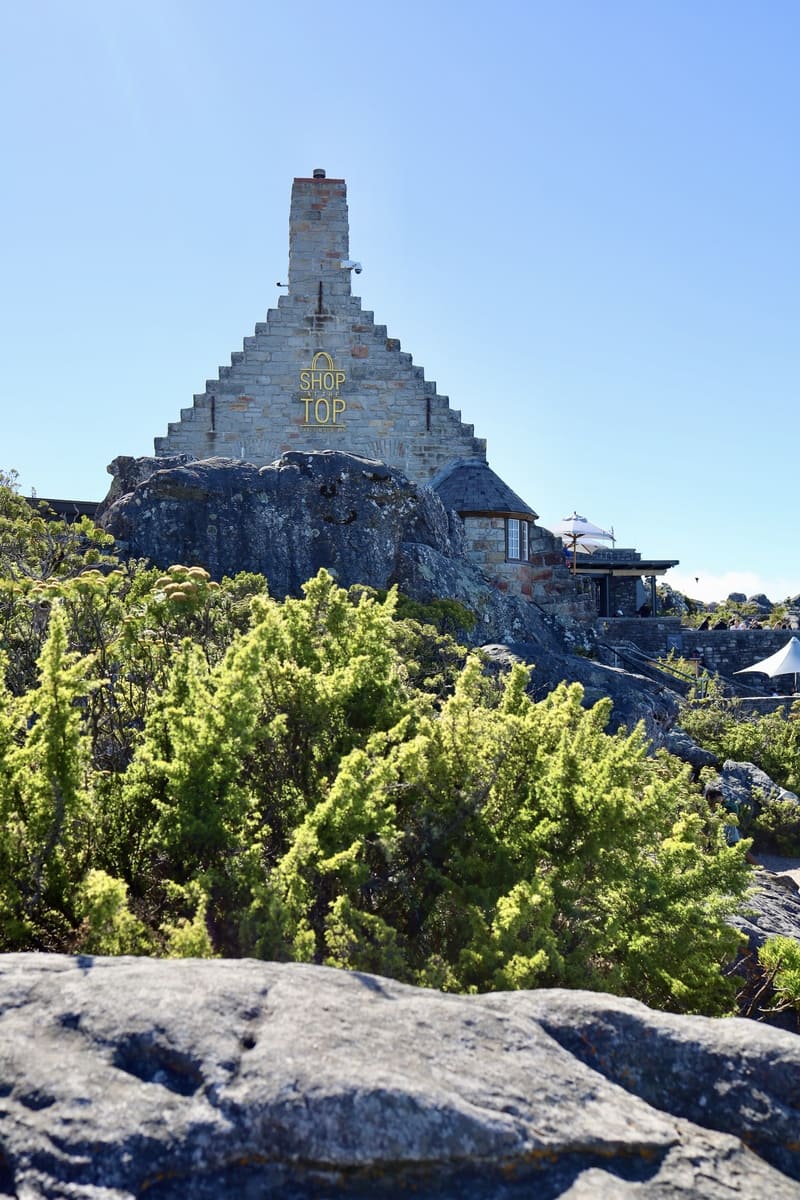
If you’re interested in learning more about what you’re seeing, free walking tours leave from the upper cable station at 10:00 am and noon.
It’s a great way to get insight into the unique biodiversity and history of the mountain without having to plan anything extra.
If you enjoyed our 3-day Cape Town itinerary, you’ll remember Table Mountain was one of the top highlights.
It’s even better when you give yourself time to soak it in, whether you’re up there for 30 minutes or a few hours.
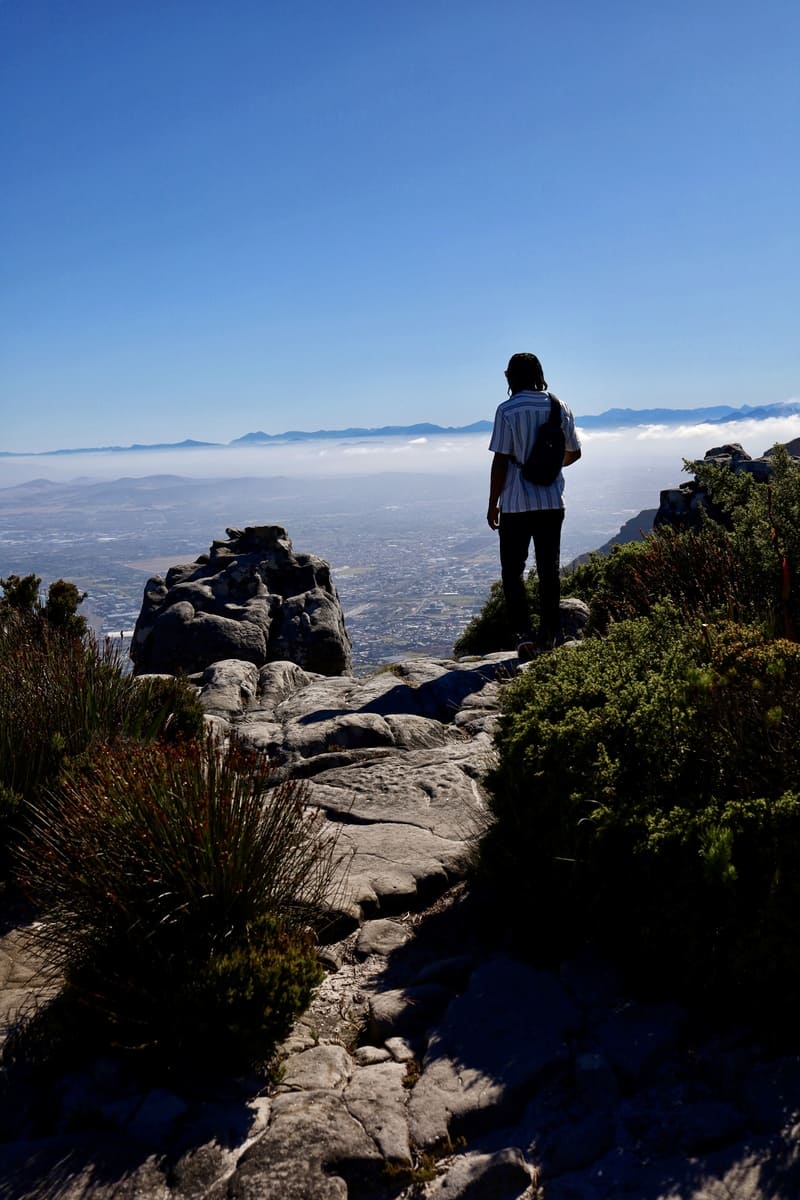
Things to Do Near Table Mountain
If you’ve got extra time in your itinerary or are looking to plan your day around Table Mountain, here are a few great stops nearby.
Kirstenbosch Botanical Gardens
A short drive from the mountain’s base, these expansive gardens sit right on the eastern slopes of Table Mountain.
They’re peaceful, beautifully maintained, and full of indigenous plants you won’t find anywhere else.
Don’t miss the treetop canopy walkway that’s included in the entrance fee of ~$5 USD per person.
It gives you a whole new vantage point of the surrounding landscape.
Lion’s Head
This neighboring peak is perfect if you’re up for another hike but want something a bit less intense than Table Mountain’s longer trails.
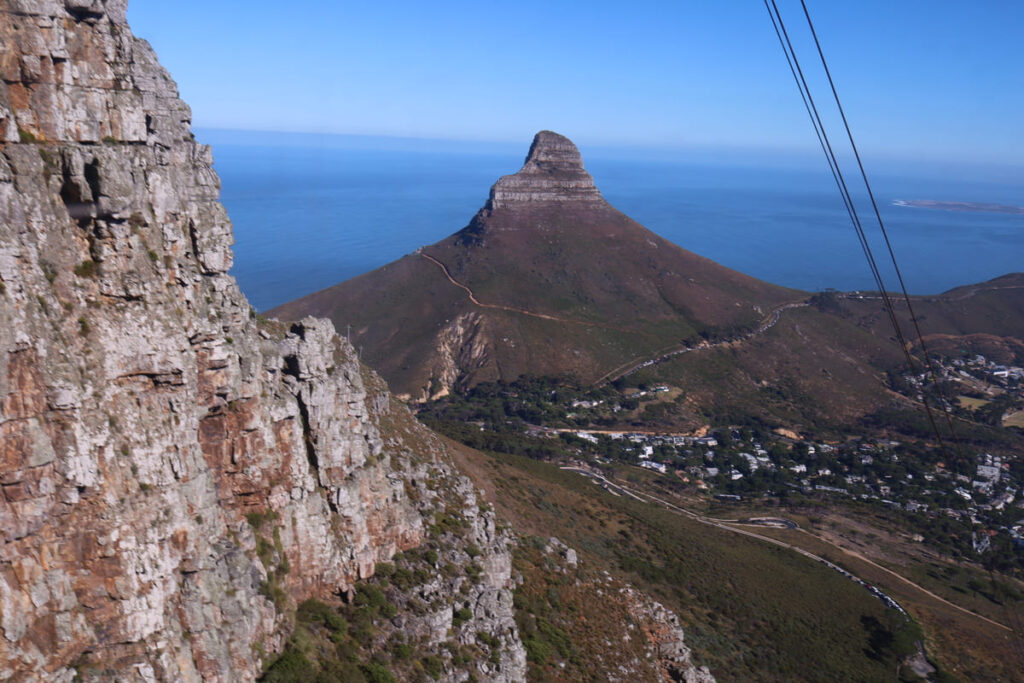
The path winds around the mountain, so you get panoramic views the whole way up.
It’s especially popular for sunrise and full moon hikes, so time your visit if you can. It typically takes about 3 hours round-trip to complete.
Camps Bay
After a morning on the mountain, Camps Bay is a great spot to unwind.
The beach is lined with restaurants and cafes that are great for lunch or an early dinner.

When we visited, the waves were rough, but natural rock pools offered a calm spot for swimmers.
The water is pretty cold, though, so keep that in mind.
If you’re mapping out your Cape Town itinerary, you can check out our full 3-day guide for how we fit all of this in.
Insider Tips for Visiting Table Mountain
- Arrive Early: Mornings are usually less crowded and offer the clearest views. Parking fills up quickly, especially during peak season.
- Check the Weather: Conditions change fast. Before heading out, visit the Table Mountain Aerial Cableway website and check a reliable forecast app.
- Dress in Layers: It can feel warm at the base but windy and cool at the summit. A light jacket or windbreaker is a smart call.
- Pack Smart: Bring sunscreen, water, a snack, and your camera. The sun can be intense, even on cooler days.
- Buy Tickets Online: Save time and money by booking ahead. Online tickets are slightly cheaper and help you skip the queue.
- Stick to the Trails: Whether you’re walking at the summit or hiking up, stay on marked paths. For hikers, let someone know your route.
- Pair It with a Day Out: Table Mountain is just one part of Cape Town’s highlights. After your visit, check out nearby spots like the Old Biscuit Mill, weekend markets, or Kirstenbosch Gardens. You can also find more ideas in my full 3-Day Cape Town Itinerary.
Map Your Visit
Here’s a sample layout for planning your Table Mountain experience, whether you’re taking the cableway or hiking:
| Time | Activity |
| 07:30–08:00 | Arrive and park near the lower cableway station |
| 08:00–08:30 | Take the cable car or begin your hike |
| 08:30–10:00 | Walk the summit trails and take in the views |
| 10:00–10:45 | Join a free guided walking tour (optional) |
| 11:00–12:00 | Grab a snack or visit the souvenir shop |
| 12:00–12:30 | Ride the cable car down or begin your descent |
| 12:30–13:00 | Head to nearby attractions like Kirstenbosch |
Adjust based on your pace and whether you hike or take the tram.
If you’re aiming for sunset, just reverse the order and give yourself extra time for parking and weather changes.
FAQs About Table Mountain
How do you access Table Mountain?: You can take the Aerial Cableway or hike one of several trails. A free shuttle runs every 10 minutes from the lower parking area to the cableway station.
How much does it cost to go to Table Mountain?: Tickets for the Aerial Cableway are around ZAR 430 online or ZAR 490 on-site for adults. Afternoon tickets are slightly cheaper.
How much time do you need for Table Mountain?: Plan for 1–2 hours at the summit. If you’re hiking, add extra time depending on your route and pace.
Is it worth going up Table Mountain?: Yes. The views, plant life, and experience at the summit make it one of Cape Town’s highlights.
Do I need a guide for Table Mountain?: No guide is needed for the cableway or main trails like Platteklip Gorge. A guide is helpful for more technical hikes like India Venster.
How long is the hike up Table Mountain?: Platteklip Gorge takes 40 minutes to 2 hours depending on fitness. Other trails may take longer.
How hard is the hike up Table Mountain?: Platteklip is steep but doable for most hikers. Trails like India Venster are more challenging and involve scrambling.
How long is the queue for Table Mountain?: In high season, queues can be long. Arrive early and buy your ticket online to save time.

Before You Go
Table Mountain might be the star of the show, but it’s just one part of what makes South Africa such a rewarding destination.
Whether you’re planning a quick trip to Cape Town or exploring more of the country, having a plan makes all the difference.
If you’re looking for a practical way to piece it all together—flights, transport, what to eat, where to stay, and how to do it all without blowing your budget—I’ve put everything I know into my Explore South Africa Travel Guide.
It’s a 28-page digital resource covering Cape Town, Johannesburg, and surrounding safaris.
You’ll find real-world tips, a fully mapped itinerary, and recommendations for the best experiences across every budget.
It’s the guide I wish I had when we first visited.
📍 Get details on transport, safety, and what to pack
🍲 Discover 25+ things to do and 20+ restaurants worth your time
🗺️ Follow a curated itinerary to see the best without stressing over logistics

If you’re ready to build your dream trip (without the overwhelm), download the Explore South Africa Travel Guide here.

